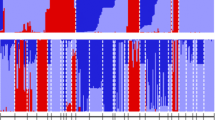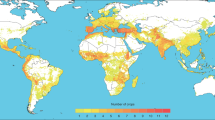Abstract
Information on the adaptation of germplasm pools to specific agroclimatic conditions is essential for ensuring high genetic progress while broadening the genetic base of breeding programmes. This study aimed to provide an ecological classification of global white lupin (Lupinus albus L.) landrace genetic resources on the basis of their adaptation pattern, verifying whether region of origin could conveniently contribute to such a classification. Some 113 landraces representing 11 regional pools were evaluated in three major agroclimatic conditions, i.e., Mediterranean and subcontinental climate in Italy under autumn sowing, and suboceanic climate in France under spring sowing. The classification of regional pools by pattern analysis suggested the presence of five major ecological groups composed as follows: A = Azores, Greece and Italy; B = Madeira and Canaries; C = Maghreb, Portugal and Spain; D = East Africa, Egypt and West Asia; and E = Turkey. This classification implied specific adaptation ranging from the cold-prone, autumn-sown environment (group A) to the spring-sown environment (groups D and E). Ecological grouping accounted for about half of the overall genotypic variation and genotype × environment interaction variation in just 3.6% of its degrees of freedom in an analysis of variance. It reflected largely the entry groups issued by pattern analysis classification of the individual accessions. Our classification of ecological groups can drive the incorporation of exotic genetic resources in European breeding programmes as a function of the targeted agroclimatic conditions. In addition, it can contribute to the definition of global or user-specific core collections.


Similar content being viewed by others
References
Annicchiarico P (2008) Adaptation of cool-season grain legume species across climatically-contrasting environments of southern Europe. Agron J 100:1647–1654
Annicchiarico P, Royo C, Bellah F, Moragues M (2009) Relationships among adaptation patterns, morphophysiological traits and molecular markers in durum wheat. Plant Breed 128:164–171
Annicchiarico P, Harzic N, Carroni AM (2010) Adaptation, diversity, and exploitation of global white lupin (Lupinus albus L.) landrace genetic resources. Field Crops Res 119:114–124
Arendt J, Reznick D (2008) Convergence and parallelism reconsidered: what have we learned about the genetics of adaptation? Trends Ecol Evol 23:26–32
Arnoldi A (2005) Optimized processes for preparing healthy and added value food ingredients from lupin kernels, the European protein-rich grain legume. Aracne, Rome
Atkins CA, Smith PMC, Gupta S, Jones MGK, Caligari PDS (1998) Genetics, cytology and biotechnology. In: Gladstones JS, Atkins C, Hamblin J (eds) Lupins as crop plants: biology, production and utilization. CABI, Wallingford, pp 67–92
Buirchell BJ, Cowling WA (1998) In: Gladstones JS, Atkins C, Hamblin J (eds) Lupins as crop plants: biology, production and utilization. CABI, Wallingford, pp 41–66
Cooper M, DeLacy IH, Basford KE (1996) Relationships among analytical methods used to study genotypic adaptation in multi-environment trials. In: Cooper M, Hammer GL (eds) Plant adaptation and crop improvement. CABI, Wallingford, pp 193–224
Duvick DN (1984) Genetic diversity in major farm crops on the farm and in reserve. Econ Bot 38:161–178
FAO (1998) The state of the world’s plant genetic resources for food and agriculture. Food and Agriculture Organization, Rome
Gepts P (1995) Genetic markers and core collections. In: Hodgkin T, Brown AHD, van Hintum TJL, Morales EAV (eds) Core collections of plant genetic resources. Wiley & Sons, Chichester, pp 127–146
Gladstones JS (1998) Distribution, origin, taxonomy, history and importance. In: Gladstones JS, Atkins C, Hamblin J (eds) Lupins as crop plants: biology, production and utilization. CABI, Wallingford, pp 1–39
Huyghe C (1997) White lupin (Lupinus albus L.). Field Crops Res 53:147–160
IRRI (2008) CropStat for Windows Version 5. International Rice Research Institute, Los Baños
Jana S (1999) Some recent issues on the conservation of crop genetic resources in developing countries. Genome 42:562–569
Jayasundara HPS, Thomson BD, Tang C (1998) Responses of cool season grain legumes to soil abiotic stresses. Adv Agron 63:77–151
Kannenberg IW, Falk DE (1995) Models for activation of plant genetic resources for crop breeding programs. Can J Plant Sci 75:45–53
Knüpffer H, van Hintum TJL (1995) The barley core collection: an international effort. In: Hodgkin T, Brown AHD, van Hintum TJL, Morales EAV (eds) Core collections of plant genetic resources. Wiley & Sons, Chichester, pp 171–178
Kurlovich BS (1998) Species and intraspecific diversity of white, blue and yellow lupins. Plant Genet Res Newsl 115:23–32
Mackay MC (1995) One core collection or many? In: Hodgkin T, Brown AHD, van Hintum TJL, Morales EAV (eds) Core collections of plant genetic resources. Wiley & Sons, Chichester, pp 199–210
Noffsinger SL, van Santen E (2005) Evaluation of Lupinus albus L. germplasm for the southeastern USA. Crop Sci 45:1941–1950
Papineau J, Huyghe C (2004) Le lupin doux protéagineux. Editions France Agricole, Paris
Pecetti L, Annicchiarico P, Damania AB (1992) Biodiversity in a germplasm collection of durum wheat. Euphytica 60:229–238
Peeters JP, Martinelli JA (1989) Hierarchical cluster analysis as a tool to manage variation in germplasm collections. Theor Appl Genet 78:42–48
Perry MC, McIntosh MS (1991) Geographical patterns of variation in the USDA soybean germplasm collection. I. Morphological traits. Crop Sci 31:1350–1355
Plucknett DL, Smith NJH, Williams JT, Anishetty NM (1987) Gene banks and world’s food. Princeton Univ Press, Princeton
Rasmusson DC, Phillips RL (1997) Plant breeding progress and genetic diversity from de novo variation and elevated epistasis. Crop Sci 37:303–310
SAS Institute Inc (1999) SAS/STAT user’s guide–Version 8. SAS Institute Inc., Cary
Simpson MJA (1986) Geographical variation in Lupinus albus L. II. Northwest Spain, the Nile Valley, the Balkans and Turkey. Z Pflanzenzücht 96:241–251
Spagnoletti-Zeuli PL, Qualset CO (1987) Geographical diversity for quantitative spike characters in a world collection of durum wheat. Crop Sci 27:235–241
Spoor W, Simmonds NW (2001) Base-broadening: introgression and incorporation. In: Cooper HD, Spillane C, Hodgkin T (eds) Broadening the genetic base of crop production. CABI, Wallingford, pp 71–79
van Hintum TJL (1995) Hierarchical approaches to the analysis of genetic diversity in crop plants. In: Hodgkin T, Brown AHD, van Hintum TJL, Morales EAV (eds) Core collections of plant genetic resources. Wiley & Sons, Chichester, pp 23–34
van Hintum TJL (1999) The core selector, a system to generate representative selections of germplasm collections. Plant Genet Res Newsl 118:64–67
Acknowledgments
The work in Italy was funded by the Italian Ministry of Agricultural, Food and Forestry Policies within the projects “Plant Genetic Resources–FAO Treaty” and “Increase of protein feed production”. The excellent technical assistance by S. Proietti, L. Fraschini and P. Manunza (Italy) and by G. Rochas and N. Rousseau (France) is gratefully acknowledged.
Author information
Authors and Affiliations
Corresponding author
Rights and permissions
About this article
Cite this article
Annicchiarico, P., Harzic, N., Huyghe, C. et al. Ecological classification of white lupin landrace genetic resources. Euphytica 180, 17–25 (2011). https://doi.org/10.1007/s10681-011-0364-7
Received:
Accepted:
Published:
Issue Date:
DOI: https://doi.org/10.1007/s10681-011-0364-7




